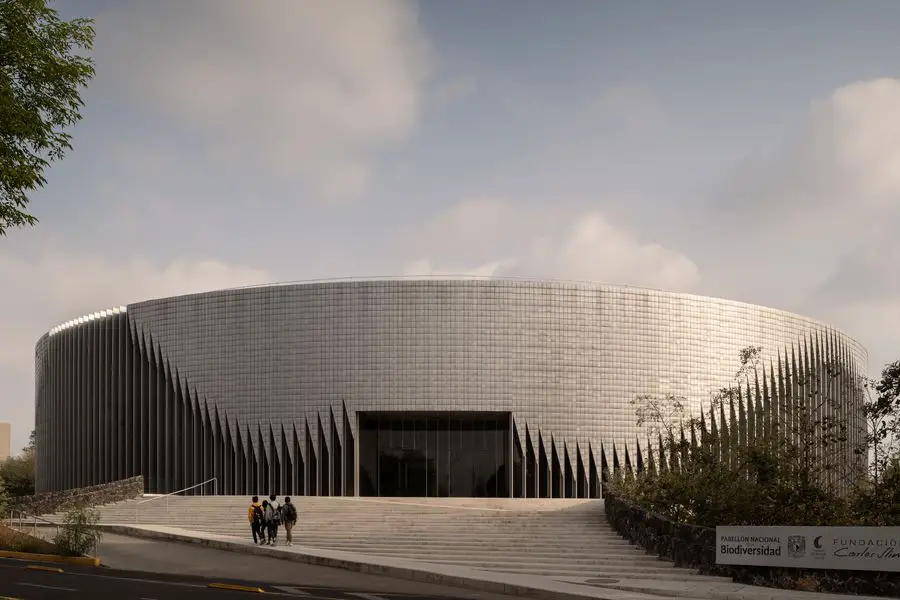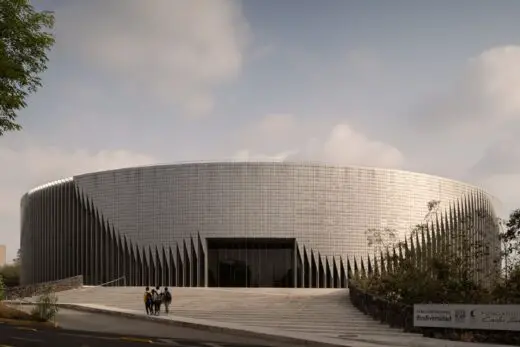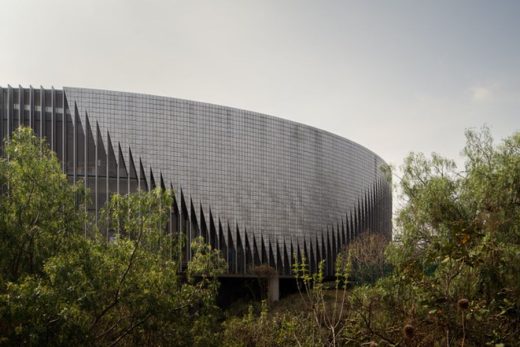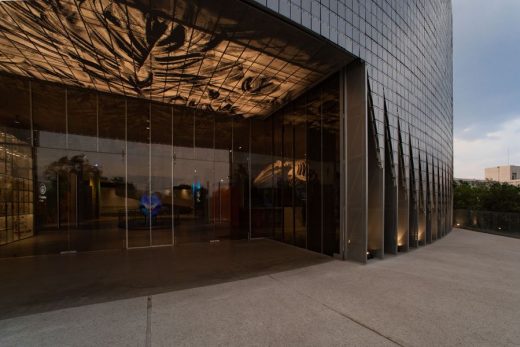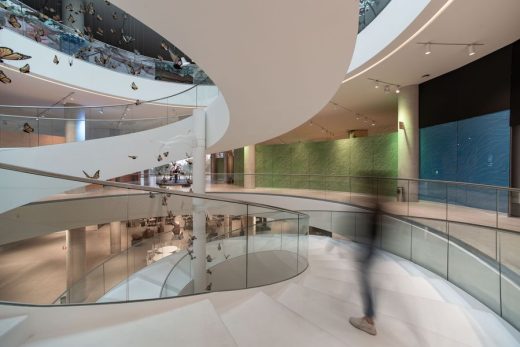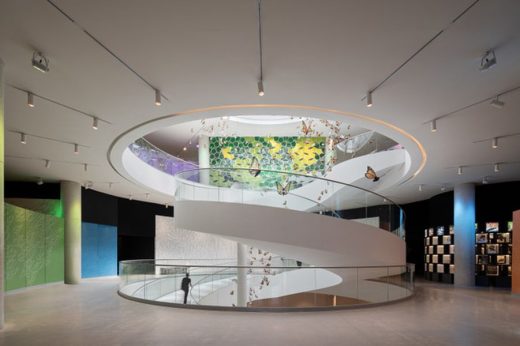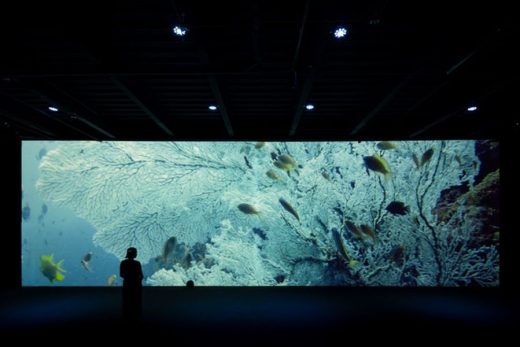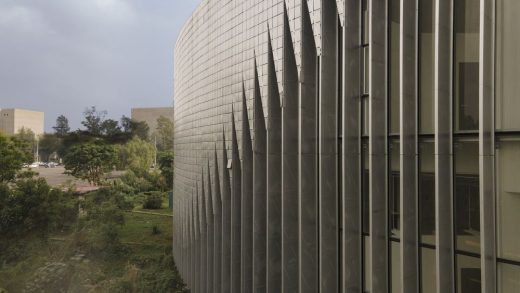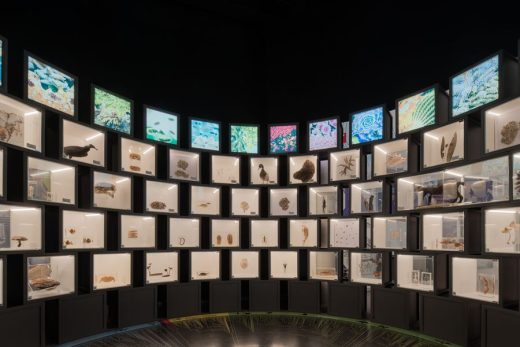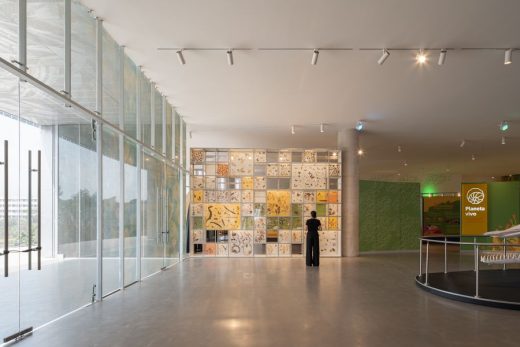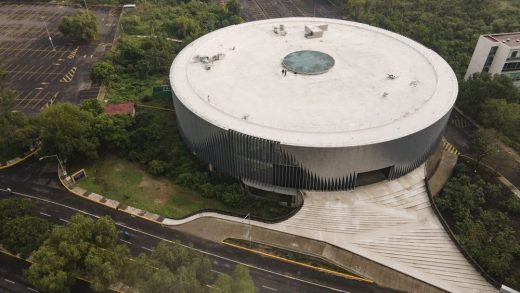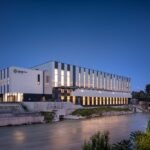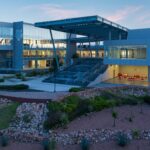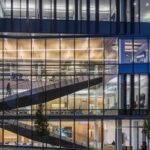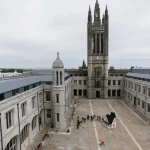The National Biodiversity Pavilion, Mexico City Building Project, Mexican Architecture, Architect, Images
The National Biodiversity Pavilion in Mexico City
28 July 2023
Design: Fernanda Ahumada + FREE
Location: UNAM, Ciudad Universitaria, Mexico City, Mexico
Images: César Belio and Mariola Soberón
The National Biodiversity Pavilion, Mexico
The National Biodiversity Pavilion is a new space for UNAM, located in the cultural corridor of Ciudad Universitaria. The project was designed to grow and conserve the archives of the Institute of Biology, as well as to create thematic laboratories for the scientific study of the largest collection of extinct species in Latin America.
The project operates from different perspectives. Conceptually, the architectural concept proposes a radiating pattern that arises from the interpretation of the tree of life and the idea that every living being is connected. The stairs, located in the center of the building, represent the double helix of DNA, the molecule that contains the genetic makeup of all living things and the source of every species on the planet. The staircase located at the epicenter of the building is the element that connects the different spaces of the pavilion. It connects the pathways to the exhibition halls, the archive, and the laboratories, forming a radiating floor plan that represents the infinite possibilities of biodiversity. In material terms, the aluminum-glass façade and the base made of local stone connect the pavilion directly to the site.
The pavilion, with more than 11,000 square meters of construction, contains an exhibition hall and multimedia rooms, a digital library, offices, storage area, and laboratories, all arranged on three levels around a circular layout.
Each level has three rings. The first ring is for the general public and begins at the center with a vertical circulation and permanent exhibits. The second ring is for internal use and houses the collections. The last ring, which protects the rest of the program and is located at the edge of the façade, is used for specialized consultation spaces, laboratories, and curatorial offices. This mix of zones on each floor enables interaction between the building’s temporary and permanent users. The circular floor plan achieved two main objectives: on the one hand, it unites all the spaces through a single vertical core. On the other, it creates 360-degree panoramic views of the natural landscape through its façade that opens and closes in the form of a wave, based on the specific needs of the program.
A major challenge was how to distribute the archives of the Institute’s four collections—mammals, reptiles, fish and birds—due to the considerable number of square meters that had to be allocated. Each collection was strategically located to meet its needs in terms of climate, storage, and future growth. To ensure proper operation, it includes high-density storage compactors. These run on mobile metal rails to store as many species as possible in the smallest possible space. It also includes an orthogonal structure within the circular structure to optimize the storage areas and allow for future growth.
The building is accessed through a staggered esplanade that welcomes visitors and connects to the cultural corridor; this floor houses the largest exhibition area and three of the four collections, along with laboratories. The first level is the most enclosed in accordance with technical requirements and houses one of the collections, the molecular biology laboratory, the auditorium, and the administrative offices. The lower level reflects the uneven terrain; it contains the spaces with the most public use, such as the store, the cafeteria, and the digital library. By placing these areas here, it takes advantage of the direct view of the quarry while creating a quiet and introspective atmosphere. In addition, the privileged location of the site, immersed in the university’s cultural corridor, added outreach spaces to the program, in order to spark an interest in scientific careers among visitors.
In terms of its façades, the lower level functions as a showcase for endemic biodiversity by directly integrating views of the natural space surrounding the building. Both upper levels have a double façade of glass and multi-perforated aluminum that offers controlled views and unfolds in response to the lighting and ventilation needs of the interior spaces. The result is a façade made up of thousands of 30×20 cm aluminum modules that move with the wind. This movement is produced by the site’s climatic conditions and alludes to its importance in the evolution and permanence of biodiversity, creating a living façade. The base of the building is built with cantera, a volcanic stone that is the most characteristic element of the local biodiversity. It was formed by the Xitle explosion that gave its name to Pedregal, the area where Ciudad Universitaria is located. Notably, the same stone that was removed for the foundations was used to construct these walls.
The project can be summarized as a fusion between public and private spaces, where visitors can interact with the exhibits and the site. This interaction awakens curiosity about all the issues that underlie the study and conservation of these species.
The National Biodiversity Pavilion in Mexico City, Mexico – Building Information
Location: UNAM, Ciudad Universitaria, Mexico City, Mexico
Year: 2022
Area
Built: 11,780 sqm
Plot: 17,117 sqm
Architects
Fernanda Ahumada + FREE
Design team
Karen García Villegas, Christiane Salem, Francisco Román, Alejandro Marin
Website: https://www.fundacioncarlosslim.org,
Photography
César Belio | @cesarbelio
Mariola Soberón | @mariola.soberon
Collaborators
Execituve project: Reactiva Arquitectura — Laura Dominguez + Ana Paula Herrera
Lighting design: ILWT
Aluminum and façades: IASA
Museography : Alejandro Nasta + Instituto Biología UNAM
The National Biodiversity Pavilion, Mexico City images / information received 280723
Location: Mexico City, México, North America
Mexican Architecture
Contemporary Mexican Buildings
Mexican Architectural Designs – chronological list
Mexico City Architecture Tours – city walks by e-architect
Mexican Properties – Selection
Pedegal House, Mérida, Yucatán
Design: R79 taller de arquitectura
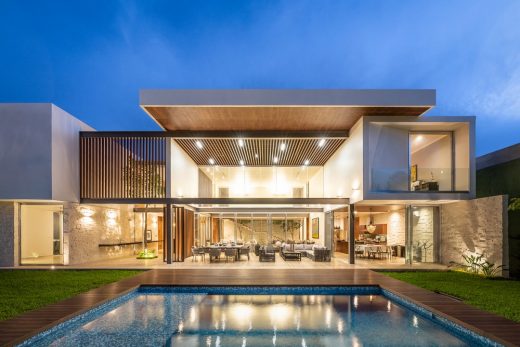
photograph : Manolo R Solís
Pedegal House in Mérida, Yucatán
Casa Huizache, San Miguel de Allende
Architect: Paul Cremoux W.
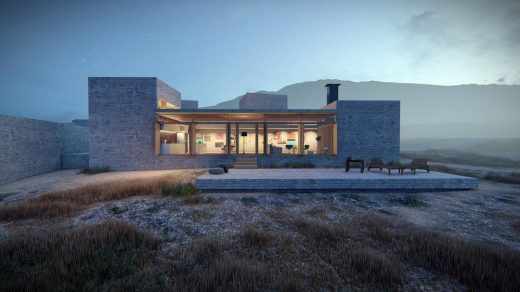
image Courtesy architecture office
Casa Huizache
Mexican Architecture – Selection
Heineken House, Polanco, Mexico City
Design: Art Arquitectos
Heineken House Mexico City
Ciudad Gobierno del Estado de Zacatecas, central Mexico
Design: Arditti + RDT Architects
Ciudad Gobierno del Estado de Zacatecas
Museo Soumaya
Design: FREE | Fernando Romero EnterprisE
Museo Soumaya
Comments / photos for the Environmental Culture Center, Mexico City – designed by A-001 Taller de Arquitectura page welcome

